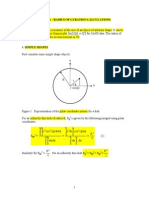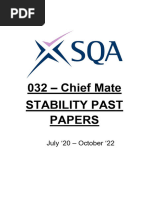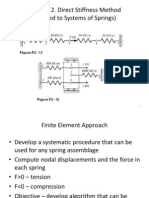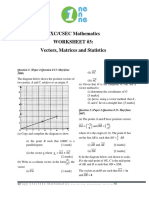Vectors in Two & Three Dimensions Exercise PDF
Uploaded by
wolfretonmathsVectors in Two & Three Dimensions Exercise PDF
Uploaded by
wolfretonmathsAQA Core 4 Vectors
Section 1: Vectors in two and three dimensions
Exercise
1. Write the following vectors in component form.
(i)
(ii)
j
4
2
2
4
-4
-2
-2
2. Find the magnitude of each of these vectors.
3
3
(i)
(ii)
(iii)
4
6
1
1
3. Write in component form the vector represented by a line from the point A (4, -1)
to the point B (3, 7).
3
4. The vectors a, b and c are given by a = , b =
4
Find the vectors
(i) b + 2a
(ii) 2c b
(iii) a b + 3c
2
and c =
5
1
.
3
5. In the diagram below, N is the midpoint of OB and M the midpoint of AC.
B
A
a
b
O
c
C
(i)
(ii)
(iii)
(iv)
(v)
Express AB and AC in terms of a, b and c.
Express AM in terms of a and c.
Find the position vector of M.
Write NM in terms of a, b and c.
If N and M coincide, write down an equation connecting a, b and c.
1 of 2
18/03/13 MEI
AQA C4 Vectors 1 Exercise
6. The position vectors of A, B and C in the parallelogram ABCD are a, b, and c
respectively. Find the position vector of D.
7. Find the magnitude of each of these vectors.
1
2
(i) 2
(ii) 1
3
4
3
(iii) 0
2
8. Write in component form the vector represented by a line from the point
X (3, -1, 1) to the point Y (1, 4, -3).
2
9. The vectors a, b and c are given by a = 1 , b =
1
Find the vectors
(i) 2b + 3c
(ii) a 4b
(iii) 3a + b 2c
2
0 and c =
5
1
2 .
3
10. Using vector methods show that X(3, -4, 0), Y(-1, 8, -8) and Z(6, -13, 6) are
collinear.
2 of 2
18/03/13 MEI
You might also like
- Using Parametric Equations - Solutions PDFNo ratings yetUsing Parametric Equations - Solutions PDF4 pages
- Combined Loading Exercise Sheet SolutionsNo ratings yetCombined Loading Exercise Sheet Solutions8 pages
- Radius of Gyration For Various Objects PDF100% (1)Radius of Gyration For Various Objects PDF12 pages
- Solving Simultaneous Equations Using Algebraic MethodNo ratings yetSolving Simultaneous Equations Using Algebraic Method29 pages
- CM-SQA-Stability-Past-Papers - July 20 - October 22No ratings yetCM-SQA-Stability-Past-Papers - July 20 - October 2250 pages
- 9th Heron Formula Proof and Test QuestionsNo ratings yet9th Heron Formula Proof and Test Questions3 pages
- Vectors and Force System (Lec 7) ME 121No ratings yetVectors and Force System (Lec 7) ME 12116 pages
- Chapter 2. Direct Stiffness Method (Applied To Systems of Springs)No ratings yetChapter 2. Direct Stiffness Method (Applied To Systems of Springs)20 pages
- 11-NAC-Static Equilibrium State After Flooding (160213)No ratings yet11-NAC-Static Equilibrium State After Flooding (160213)19 pages
- 02-NAC-Review of Fluid Mechanics (160213)No ratings yet02-NAC-Review of Fluid Mechanics (160213)34 pages
- 04-NAC-Initial Transverse Stability (180514) - StudentNo ratings yet04-NAC-Initial Transverse Stability (180514) - Student23 pages
- Excel Review Center Solution To Take Home - Algebra 3No ratings yetExcel Review Center Solution To Take Home - Algebra 33 pages
- College Algebra: Analytic Geometry, 10th Ed. Brooks/Cole Publishing Co., 2001No ratings yetCollege Algebra: Analytic Geometry, 10th Ed. Brooks/Cole Publishing Co., 20011 page
- Introduction To The Stiffness (Displacement) Method: Analysis of A System of SpringsNo ratings yetIntroduction To The Stiffness (Displacement) Method: Analysis of A System of Springs43 pages
- Centroids, Centre of Mass & Centres of GravityNo ratings yetCentroids, Centre of Mass & Centres of Gravity42 pages
- (HKL) - Procedure For Finding The Miller Indices of A Plane100% (1)(HKL) - Procedure For Finding The Miller Indices of A Plane4 pages
- CHAPTER 9 Baru 1 Tutorial and All QuestionsNo ratings yetCHAPTER 9 Baru 1 Tutorial and All Questions12 pages
- Using Partial Fractions in Integration Exercise PDFNo ratings yetUsing Partial Fractions in Integration Exercise PDF1 page


















































































